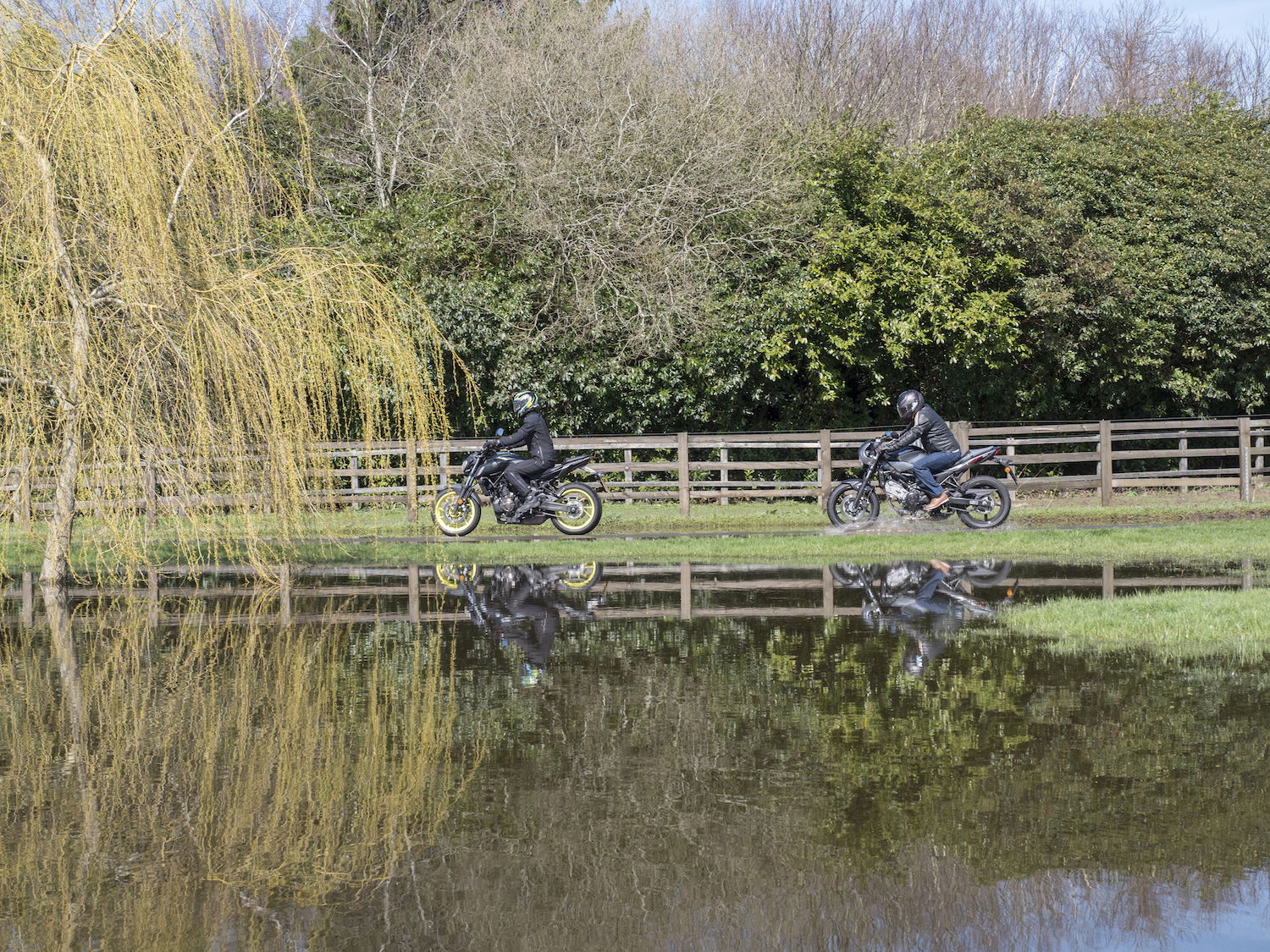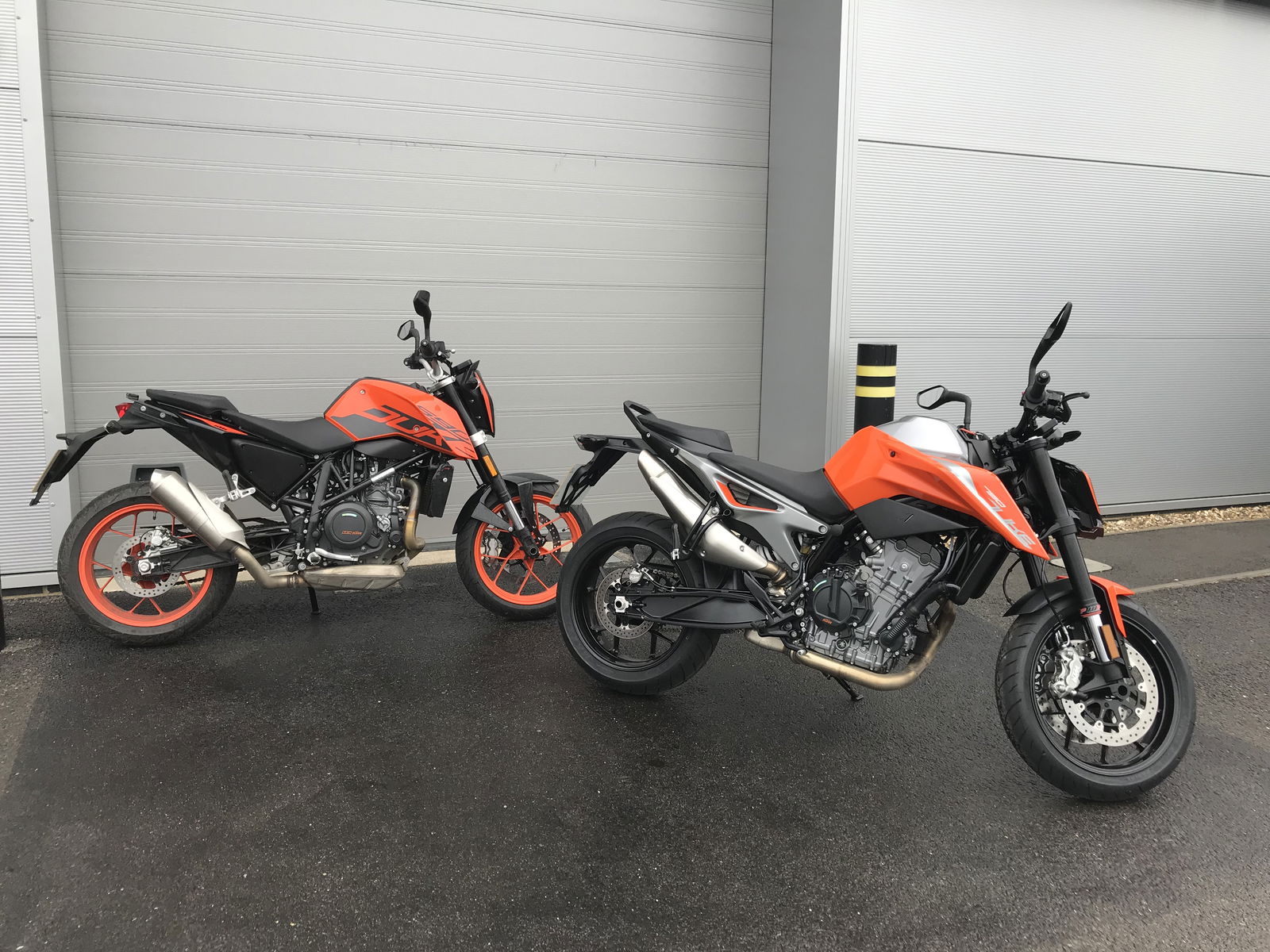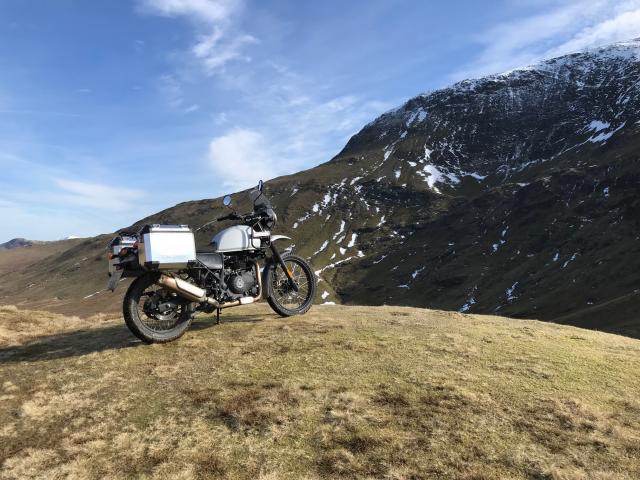New bike test: Yamaha MT-07 v Suzuki SV650X
Middle of the road, left in the garage, or right on target? We test the 2018 Yamaha MT-07 against Suzuki's new SV650X

IF YOU were to believe the mainstream media, extremism is everywhere these days, and the centre's never looked so weak. According to this theory, people worldwide are plumping for radical 'populist' politics – be they left or right – and in religion, people are either chucking it altogether, or signing up for the most arcane sects. Folk are bored, unconvinced or simply unwilling to accept the status quo, and are looking for more extreme answers to their problems.
But when it comes to bikes, the middle ground is still pretty popular. Folk love the idea of 220bhp megabikes, but the sensible head often takes over when it’s time to sign on the PCP agreement dotted line.
Here at Visordown though, we take a longer, calmer view (sometimes). So we're holding our judgement on all this for the moment, and going out for a ride instead. This time, we're riding two of the most middle-of-the-road bikes you could think of – Yamaha's MT-07 and the Suzuki SV650X. Now, if we were to go along with the extremism theory, then these bikes would be languishing at the bottom of the sales charts, unloved by punters desperate for something wilder. Instead, they’re massive sellers, the MT-07 in particular is a ubiquitous sight in the trenches of the UK’s commuter wars of a morning.
It’s not too hard to work out why. Priced to sell, and with very decent engine and chassis packages, both the MT and the SV are the sort of bread and butter bikes which keep many a dealer ticking over in the sales stakes (while waiting to sell all those lovely R1Ms and GSX-R1000Rs). But which is best? There’s only one way to find out…
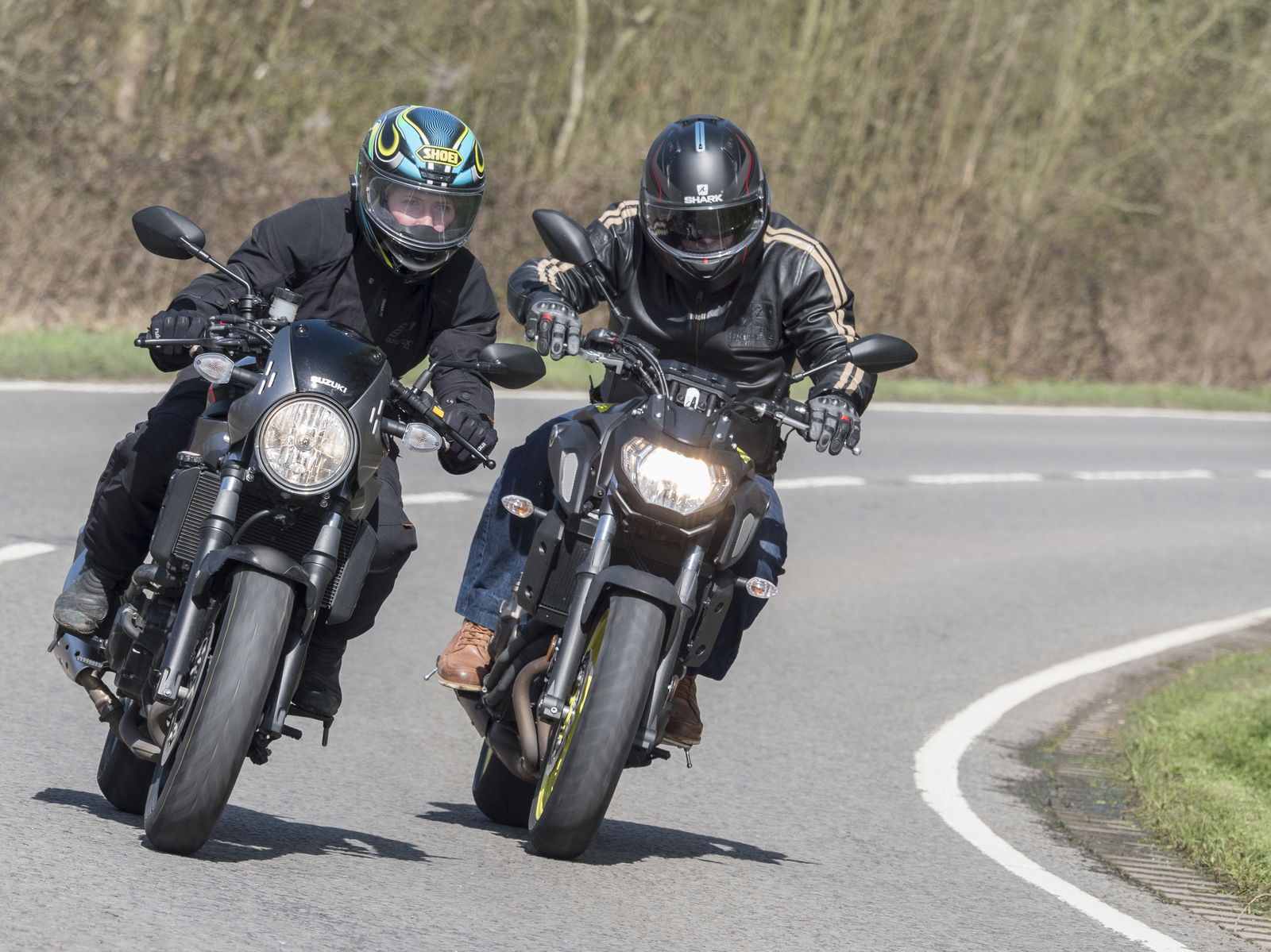
Yamaha MT-07
We covered the new MT a month or so ago from the riding launch in Spain – so you should all be very well acquainted with the scenario. The little 689cc parallel twin roadster was originally launched back in 2014, and was an immediate hit with its no-nonsense performance and usability. Well priced, and ideal for novices as well as experienced hands, it sold by the containerload, and is a common sight on UK roads.
One of the few complaints centred on its cheap-shoes suspension though, so for this year, the tuning fork folks have er, tuned up the forks (and shock!), with revised settings and more adjustment. That, plus a very minor bodywork update, and comfier riding position is your lot for 2018, pretty much.
I picked the new bike up from Yamaha UK, and was immediately back in the laughing zone. This bike is just packed with fun – the motor is sharp as a needle, with bags of grunty character, and loves a wheelie – in first second, hell, even clutched in third off a rise in the road.
Even without the mono nonsense, it’s supremely satisfying – no matter where you are in the rev range, it seems to just pick up and go. Out of slow bends, going for a quick overtake on a twisty B-road, accelerating onto a motorway slip road, the little parallel twin always has your back it seems. And if you’re in pottering mood, the fuelling is spot-on at smaller throttle openings, and the power delivery is always creamy-smooth.

After the engine, the brakes are probably the next strong point in the MT-07 armoury. Just like the firm did twenty years ago with the Fazer 600, Yamaha has put top-spec four-piston calipers on the MT, and while they’re not radial mounts, and the discs are on the smaller side, they still give amazing stopping power – perfectly in tune with the bike’s performance profile. They won’t overwhelm a novice grabbing a handful in panic mode – but they give stacks of power and control to a more experienced hand.
The tweaked suspension goes under the microscope of course, but there’s not masses to say. It’s a big improvement on the older bike, according to owners we’ve spoken to, and for this class of bike, in normal road use, it’s more than good enough. Bumps are absorbed without fuss, weight transfer compresses the forks and shock progressively under braking and acceleration, and the overall feeling is of capable, decent, vanilla suspension performance.
Handling-wise, the MT is agile when you want it, and stable when you need it, with no quirks at all, even when pushing hard. If you’re really on it, or considering some trackday work, you might want some more ground clearance, but we’re straying outside the main competences a little here…
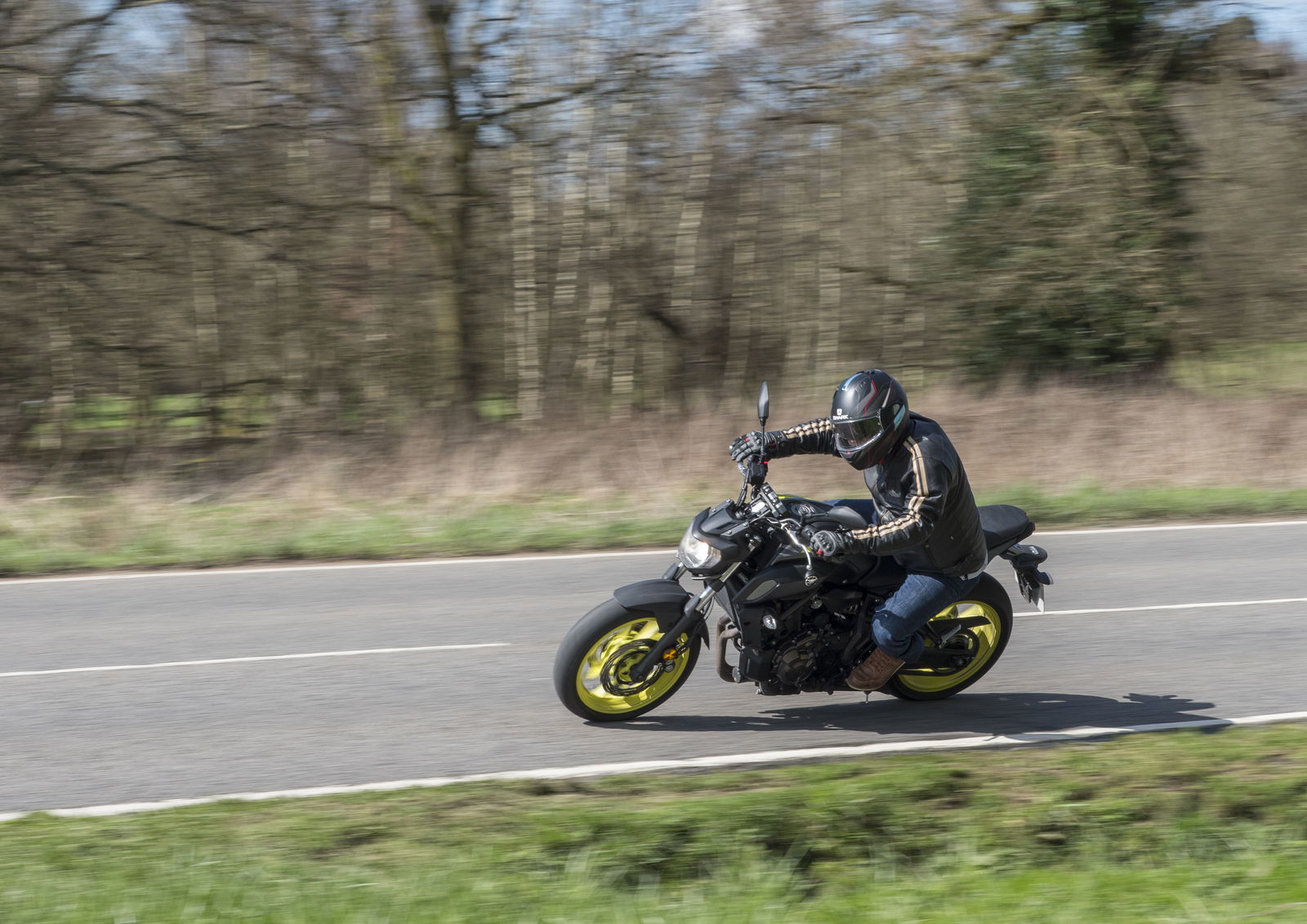
On the launch, I’d given the stock rubber a bit of a hard time, the elderly BT-023 Bridgestones feeling vague and slippery on the polished Spanish mountain asphalt we rode on. Back here in the UK though, the tyres felt much better, although I’d still consider a rubber upgrade if I was riding an MT-07 every day. The SV650X’s Dunlops feel grippier and more reassuring all round in comparison, one of the few areas where the Suzuki had a clear advantage for me.
Finally, the MT has a short but sweet kit list. There’s nothing too fancy – no unnecessary traction control or riding modes – but there is a decent mono LCD dash. We would maybe like to see something like a quickshifter in here of course, but at these price points, every fifty quid bolt-on matters, and the beancounters wouldn’t allow it.
Especially when there’s such a comprehensive official parts catalogue for the MT range. You really can go to town on the -07, with an Akrapovic pipe, hot grips, luggage, screens – there’s even a bladdy Ohlins shock and fork internal cartridge upgrade kit ffs. In some ways, it’s a bit like a budget airline flight – you can get in the hot seat for minimal pennies, but there are stacks of optional upgrades you can bolt on should you fancy, putting you in total control of what your MT-07 ends up like. A minitwin racer for the street, a sensible commuting tool, even a mini-touring fun bus. It’s all up to you (and the credit limit on your Mastercard…)
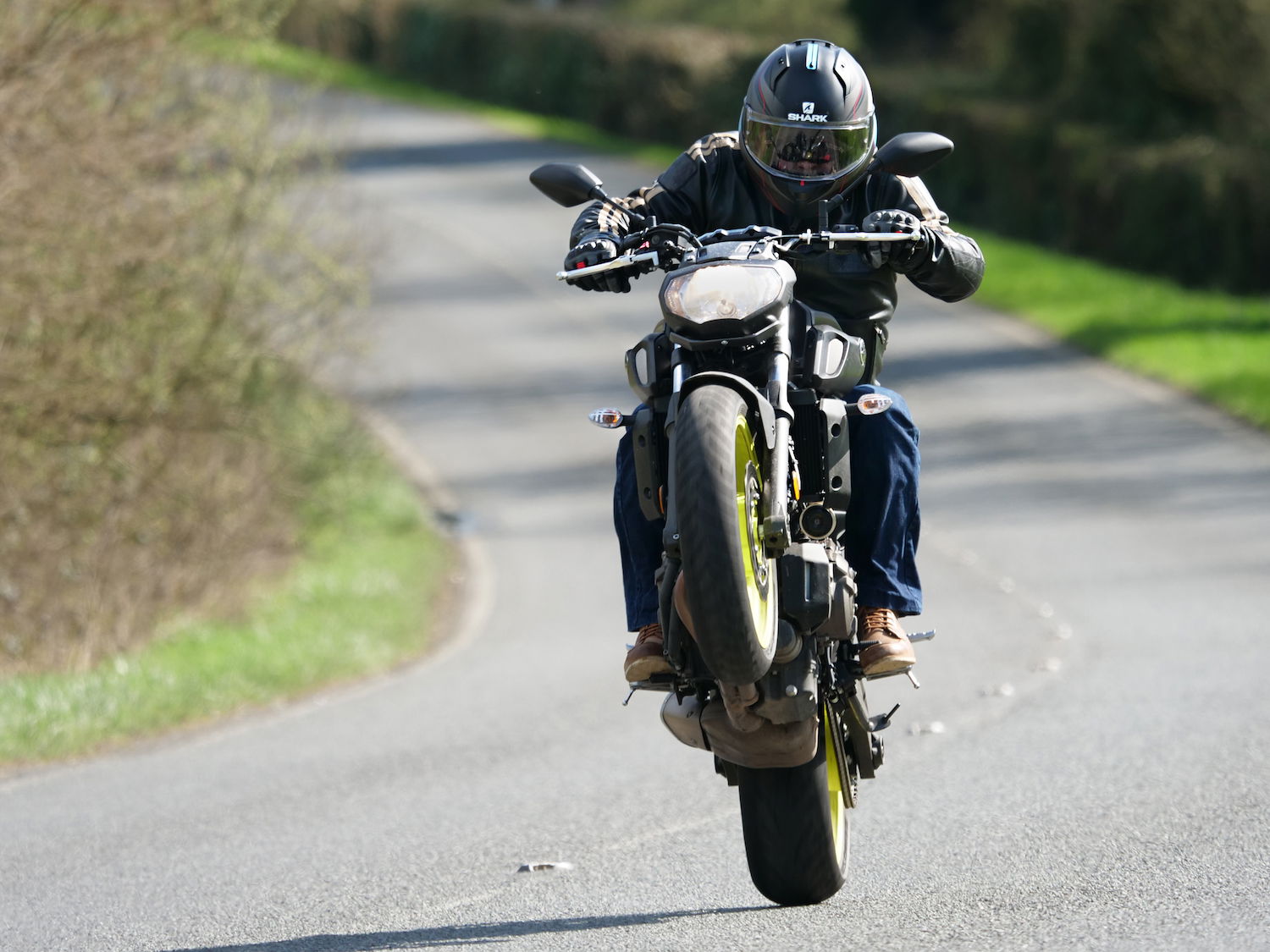
Engine: Parallel twin layout, with Yamaha’s 270° firing order crossplane crank and 689cc capacity gives a grunty midrange delivery with strong top end power.
Frame: Steel tube diamond-type, tried and tested stuff.
Suspension: The centre of the upgrades for 2018 – the rear shock now gets a rebound damping adjuster, and both forks and shock have had their spring and damping rates ramped up a notch or two. There’s 16 per cent more rebound damping and a six per cent higher spring rate on the forks while the shock has 11 per cent more spring rate, with 27 per cent more rebound and 40 per cent more compression damping on the high-speed damping circuit.
Brakes: Upper-middle class front calipers have four-pistons and semi-monobloc construction, plus conventional axial mountings. 282mm discs are on the small side, but work well.
Electronics: Standard fuel injection with conventional throttle bodies. No traction control or riding modes. LCD dash with trip computer, range, fuel gauge
SPECS
Engine: 8v parallel-twin, DOHC, liquid cooled, 689cc
Bore x stroke: 80x68.6mm
Compression ratio: 11.5:1
Max power (claimed) 74bhp@9,000rpm
Max Torque (claimed) 50ft lb@6,500rpm
Transmission: six speed, chain drive
Frame: steel tube diamond type
Front suspension: RWU 41mm KYB forks, non-adjustable
Rear suspension: KYB monoshock, preload/rebound adjustable
Brakes: Dual 282mm discs, four-piston calipers (front), 245mm disc, single-piston caliper (rear), ABS.
Wheels/tyres: Aluminium/Bridgestone BT-023, 120/70 17 front, 180/55 17 rear
Rake/trail: 24.5°/90mm
Wheelbase: 1,400mm
Kerb weight (claimed, kerb weight, full fuel tank): 182kg
Fuel capacity: 14 litres
Price: £6,349
SV650X
Ah, Suzuki. We love you and your mythical heritage, with Gixxers and Busas and RG500s and all. And the new GSX-R1000 is indeed a cracker, and our favourite litre bike from last year. But on the face of it, only having this bike as a new model for 2018 is a bit lame. We know you were all busy for 2017 putting out a stack of new machinery, but still.
We’ll forgive them when they bust out a new Hayabusa, turbo 750 twin and a brace of new Gixxers this autumn of course (ha!) But, to be honest, when I first jumped onto the little SV-X, I forgot all about the ‘scant 2018 model catalogue’ carping, and just had a hoot riding the little twin. Okay, the changes are minimal over the standard machine (which I’d spent a month or so on last year), but they do make a difference. The riding position was a worry at first – would Suzuki have killed the SV’s fun by putting a stupid, fashionably-crippling riding position? BMW’s RnineT Racer and the Husqvarna Vitpilen are two of the worst offenders in this regard lately, and I’d have been pissed had Suzuki done the same thing. Thankfully, the SV-X seat-bars-pegs layout is as comfy as it is committed, and I was in relaxed mode all through the test.
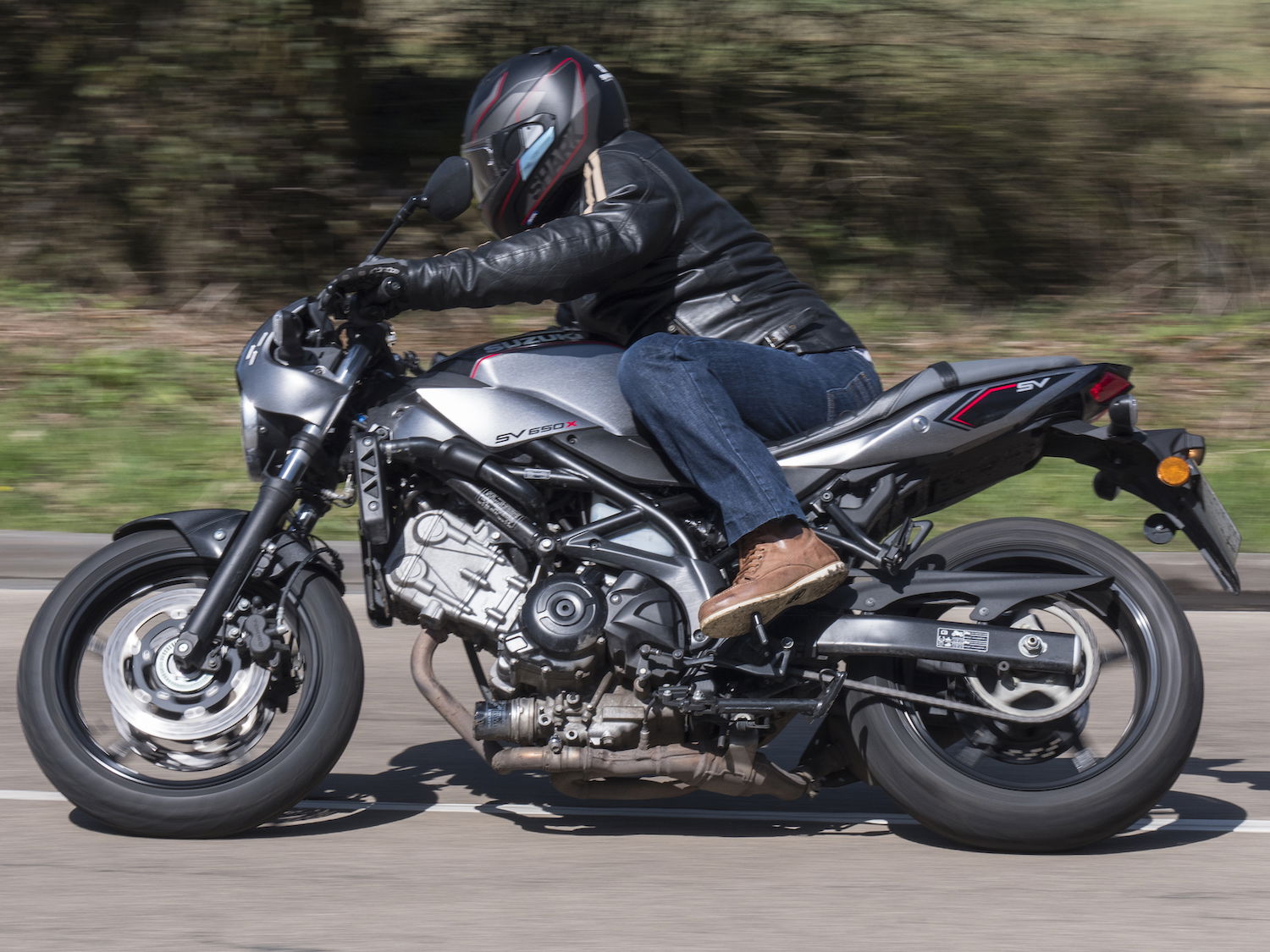
The SV engine probably deserves an award for all the bikes it’s appeared in over the years. While flasher motors have come and gone, it’s just got on with making decent power with superb reliability and solid economy for the past couple of decades. Here, it’s putting out as much power as the MT’s newer, slicker engine, even after having a major Euro4 anti-pollution makeover for last year. It now has twin-plug heads, to clean up those emissions, but the fundamentals are as they were back in the last century when the first SV was being designed.
And it’s a great little roadbike engine. A little short on instant pep compared with the MT, but get into the groove on a twisty road, and she sings away under you like a little old British sports car from the 1970s. The intake bark and exhaust tone have been cunningly crafted to sound great to the ear, while meeting the strict external noise limits of Euro4, and the results are very satisfying. You need to stir the box a bit to keep right in the power, but that’s no hardship with the slick change and clean fuelling. Like her ancestors, she’s happy enough to pop the odd wheelie here and there although she’s a bit less of a hooligan at heart than the positively delinquent Yamaha. It’s got a trendily minimal thirst, and while there are no electronic aids, you don’t miss them. Traction control, riding modes, wheelie control – none of it is needed here, although a quickshifter is always a good idea.
The brakes look basic as hell, but work well enough (albeit a little soft on initial bite), while I really liked the performance from the Dunlop Streetsmart III rubber. I only really rode it in warm dry conditions to be fair, but the grip and feedback was more than enough for this class of bike on the road. There’s plenty of ground clearance, though the pegs will go down if you go mad, and the suspension is fairly anonymous, which is probably a good thing. Overall, the chassis is skinny and lithe though, and when you want to get a wriggle on, it can cope with much more than you might think.

Engine: Same basic 90° V-twin 645cc layout as we've had since 1999, but with 60 new parts compared with the old SVF650 Gladius. Head now has dual spark ignition, to clean up emissions on the stone-age combustion chamber, and probably also gives a bit more pep. New pistons have resin coating on the skirts, and are redesigned to be lighter and stronger, yada yada. Bore and stroke and compression ratio are all as you were. Radiator, airbox and exhaust are all new too.
Fuel injection: New SDTV dual-valve throttle bodies with uprated injectors, and a cunning idle speed control circuit, that raises the revs slightly when you let the clutch out, or when running at low speeds. It helps novices avoid stalling round town.
Electrics: New LCD dash has clock, gear position, fuel consumption and fuel range displays. The SV also has Suzuki's new one-touch starter system: just push the start button once, and it keeps spinning till the engine catches. No more bothersome 'holding down the button for two seconds' for Suzuki owners!!
Chassis: Unadjustable RWU forks, preload-adjust rear shock for carrying pillions, dual twin-piston front brake calipers, 290mm discs. ABS as standard. Suzuki's made it narrower and lighter than before too: 8kg less than the ABS Gladius, which is pretty decent. There are 70 new chassis parts over the old bike. Finally, seat height is just 785mm, the lowest in the class. Perfect for stumpy folks like me!
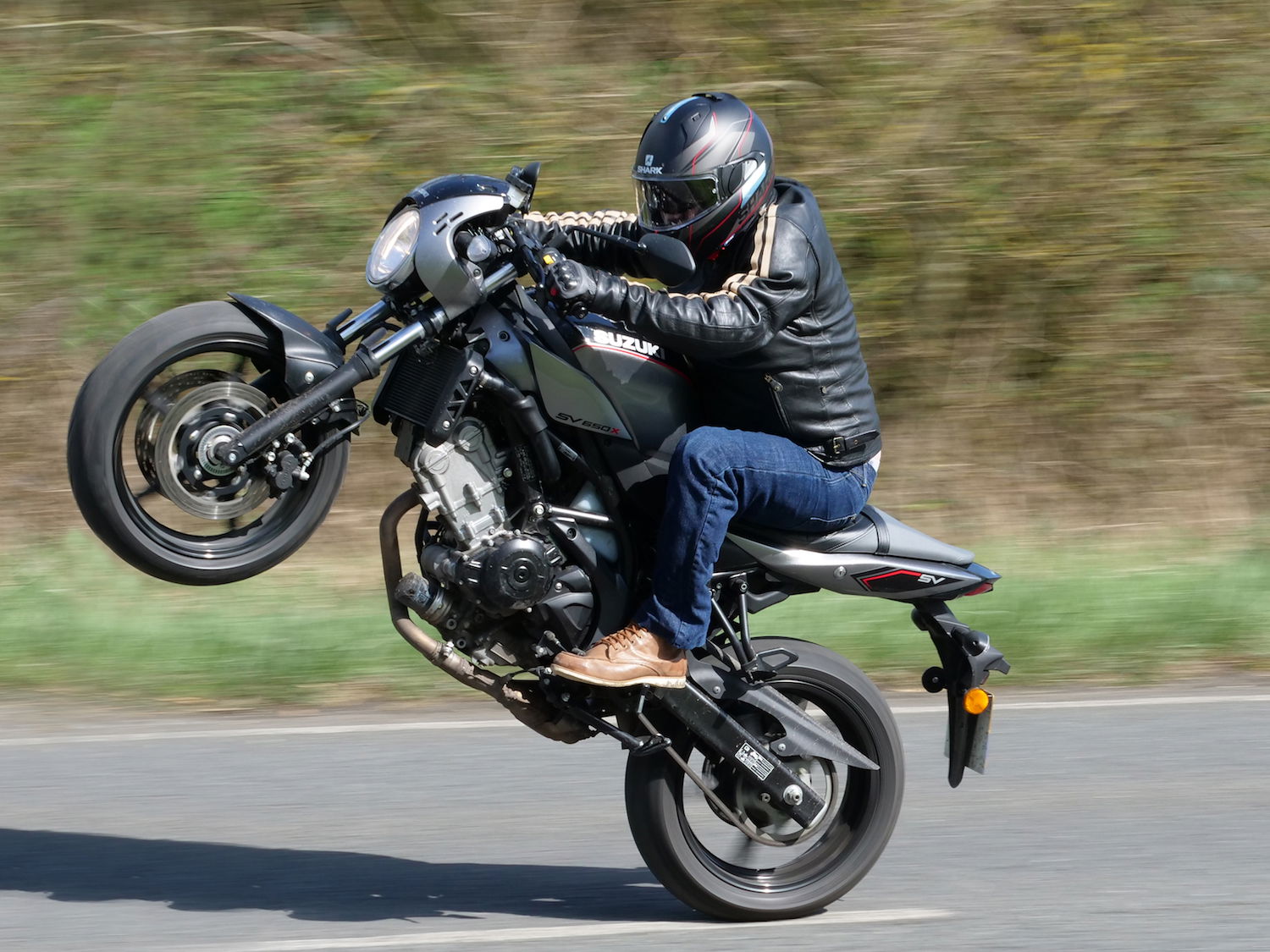
Specs
Engine: l/c, 90° V-twin, DOHC, 8v, 645cc
Bore x stroke: 81.0mm x 62.6mm
Compression ratio: 11.2:1
Maximum power: 75bhp@8,500 rpm
Maximum torque: 64Nm@8,100 rpm
Fuel system: Dual-valve fuel injection, 39mm bodies
Transmission: wet clutch, six-speed gearbox, chain final drive
Frame: aluminium trellis
Front suspension: RWU unadjustable forks
Rear suspension: Preload-adjustable monoshock
Brakes: dual 290mm discs, twin-piston calipers (front), single disc (rear)
Wheels/tyres: cast aluminium/Dunlop Qualifier, 120/70 17 (front), 160/60 17 (rear)
Rake/Trail: 25 degrees/104mm
Seat height: 785mm
Wheelbase: 1,445mm
Wet weight: 197kg
Fuel tank capacity: 13.8 litres (3 gallons)
Price: £6,199
VERDICT
I nearly – very nearly – sat on the fence a bit at the end of this test. I did enjoy my time on both these bikes, and it's fair to say that for a mid-priced, middleweight roadster, neither one misses the mark. The SV650 X does really well for such a seemingly-basic proposition, built on fairly dated foundations. It's practical, easy to get on with, frugal in running costs, and I even think it looks quite good. Best of all though, it's a fun bike to ride. Too often, firms turn out machinery which ticks all the beancounter's boxes, but forgets to offer any actual enjoyment. Suzuki's done well here though, and I had a hoot on the SV – get it on a twisty back road, on a sunny day, and you'll be grinning like a loon under your lid. It wheelies, the tyres are good, the handling is fine, and it has just enough kit to keep it in touch with 2018.
The MT-07 is a cut above in (almost) every department though. It looks sharper and more modern, and you feel like you're getting a bike from 2018 rather than 2008. The engine is stronger, lustier, and packs more laughs into every turn of its crankshaft, while the brakes are a notch up in power and sophistication. The handling is on par with the Suzuki, but the suspension offers more control. There’s less wind protection from the Yamaha’s upright riding position, but conversely you get a better view round town. The SV’s teeny nosecone doesn’t do much in terms of protection, and there are optional screens for the MT, so that can all be tailored to suit.
The price is also relevant. I had thought the gap was wider than it actually is – but the MT is only £150 more than the SV, and that’s not really enough. I suspect the street prices might give more of a price differential, but on the list prices, the Yamaha offers more for your cash.
So, the MT-07 wins this particular battle for the middle ground! There’s not a lot in it though – and if you’re sold on the SV’s looks, or live nearer to a Suzuki shop, then you’re not missing out by much by plumping for team ‘S’.
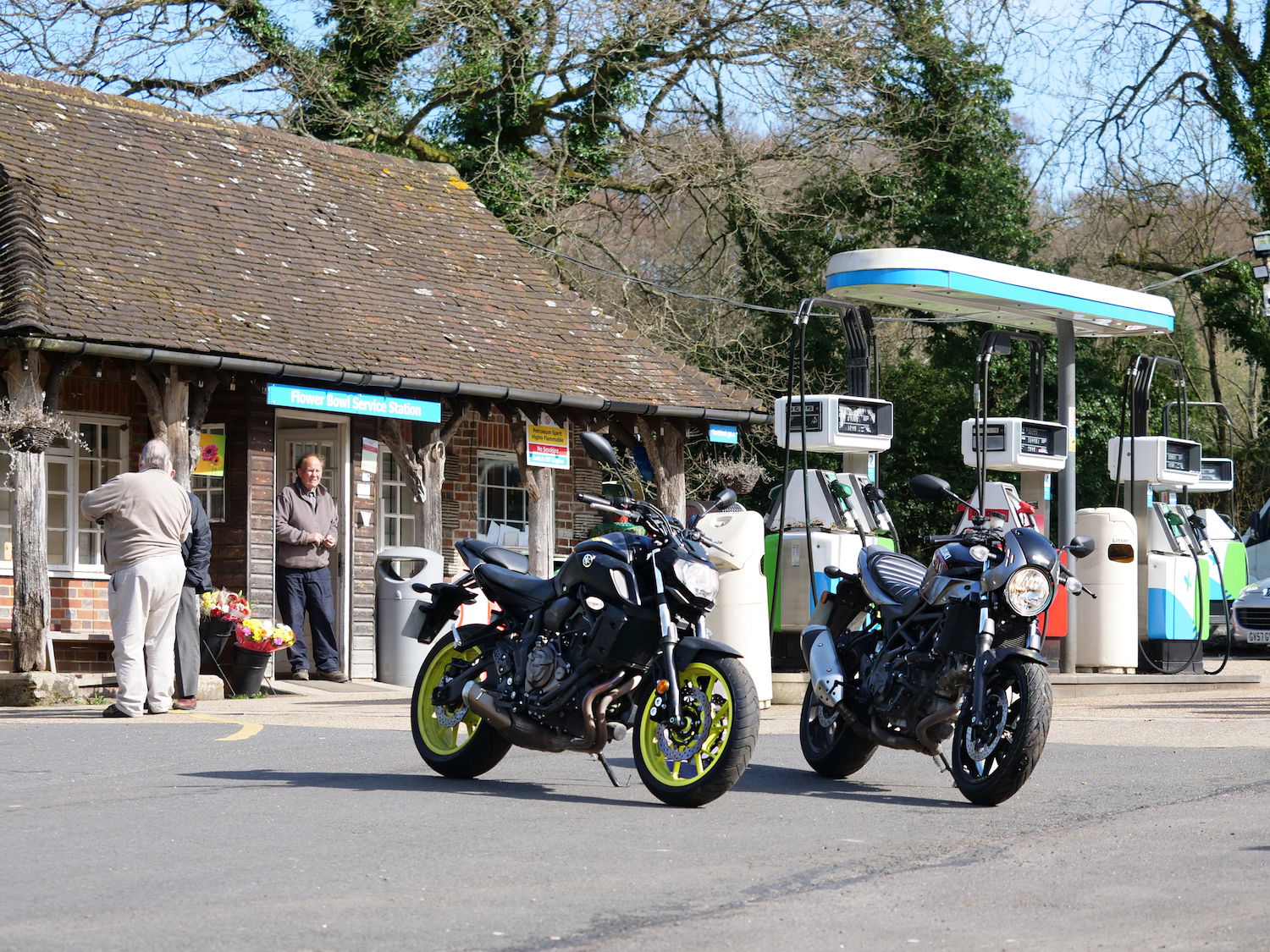
SECOND OPINION
Suzuki’s SV650 has to be one of the most popular bikes around. Since launch in 1999 it has become a staple among young, old and commuters alike.
It offers reliability, economy and not-bad power in in a comfortable, affordable package.
On paper it’s the ideal bike. But it’s just never really done anything for me, and its latest guise – the café racer styled ‘X’ model – is to my mind the worst of the lot.
As Suzuki’s only new model of 2018, it feels a little like an afterthought, a bitsa created from from mismatched parts in the workshop thrown on to the antiquated SV base. It’s just a bit too sporty and plasticy to fit in the retro market, and that exhaust is a huge turn off.
But looks aside, it’s not actually bad to ride. The downturned bars aren’t wrist breakers, and the sporty riding position at least allows you to pretend you’re accelerating as fast as the middleweight MT. The suspension is capable and the brakes just about adequate – at a squeeze. There are no electronic aids, but our sunny ride didn’t call for them anyway – apart from wheelie control, Al could have done with that!
If the SV is like Alan – old, boring and terribly dressed – then I’d be the boisterous, over-excitable MT.
It’s so much cooler than the SV, with shouty looks that appeal to millennials and old guys alike. The grey and yellow colour scheme is my favourite of the MT family, and it perfectly suits the bike’s aggressive nature.
At first, fresh from a few hundred miles on the SV, I found the MT’s upright position alien – the bars felt far too close, even to my short arms. In heavy traffic though, it proved its weight in gold, with the ability to shimmy through gaps in traffic and make tight turns in small spaces.
On open roads, the 689cc parallel twin came into its own, offering tons of grin-inducing power, delivered in an achingly sharp manner. And those upright bars not only made for a comfortable, flickable riding style, but also gave excellent visibility.
New suspension on the 2018 model makes for a comfier ride than previously, and the sharp brakes stood miles above the SV.
With such a small price difference between the two, and such a large prejudice against the SV, I’d go for the MT, any day.
